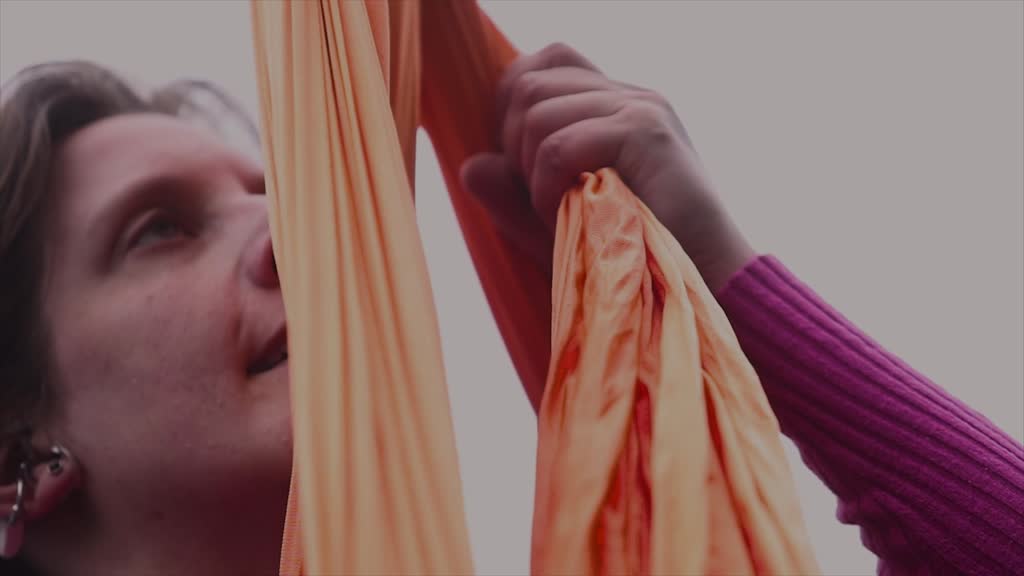By Colleen Schrappen
St. Louis Post-Dispatch
WWR Article Summary (tl;dr) Christina Stephens started taking aerial classes about six months after her left leg was amputated below the knee in January 2013.
St. Louis
Christina Stephens’ persistence at Bumbershoot Aerial Arts is paying off.
She hoists herself off the ground, grabs ahold of two lime-green swaths of fabric suspended from the ceiling of the Benton Park studio, and starts her serpentine ascent.
She has come a long way since her first silks class four years ago, strengthening her core, improving her flexibility and gaining confidence.
Stephens, 35, started taking aerial classes about six months after her left leg was amputated below the knee in January 2013.
“It was kind of a learning process on how I can do tricks and techniques with a prosthesis,” she says.
As she would climb up and down, twisting and inverting her body, her artificial leg had a tendency to pop off.
Eventually, she switched to a device with a vacuum system that keeps the foot in place, though she also sometimes practices without a prosthesis.
Before she lost her leg, Stephens, who lives in the Lemay area of south St. Louis County, had not considered herself particularly adventurous.
“I’m way more active now,” she says. “I feel like I have something to prove.”
‘FORM OVER FUNCTION’
A shade-tree mechanic, Stephens was changing the brakes on her car when her left foot was crushed. The damage was more extensive than her doctor initially thought. Stephens, who has a doctorate in occupational therapy from Washington University, did some research and pushed for amputation.
“As an OT, I’m into form over function,” she says. “I read about foot salvage and amputation. I didn’t want to end up with a brick at the end of my leg that I couldn’t run on.”
After she made her decision, Stephens searched the internet for first-hand accounts of limb loss so she would know what to expect. She came up empty.
So she started her own YouTube channel, AmputeeOT, documenting every step from presurgery and the removal of her cast to hobbling around on crutches and walking on the prosthesis for the first time, “it’s my opportunity not to be pigeon-toed,” she jokes in that episode.
“Making a channel is how I dealt with the accident,” Stephens says.
As she healed, her topics evolved. Some were instructive: how to get in a car, put on pants, sweat less, take a bath. Others reflect on the difficult and “awesome” aspects of being an amputee. Her droll sense of humor is prominent in episodes such as “Help! My Prosthetic Leg is Stuck” and as she celebrates her one-year “ampu-versary” by wearing a party hat on her residual leg.
A video of Stephens building and walking on a prosthetic leg made of Legos has attracted 6.3 million views. In other episodes, she clomps about on a milk crate, a volleyball and a pumpkin.
It’s not exactly the typical approach to limb loss.
“Putting it out there, that’s something I learned about Christina quickly,” says Jerod Wexstten, a prosthetist who has worked with Stephens since her accident.
Wexstten himself is an amputee. He lost his left leg below the knee several years ago, after an injury left him with excruciating nerve pain.
“The typical patient is from an older generation,” says Wexstten, 38. “They often want to keep it to themselves.”
Almost 70 percent of amputees are male, and almost 9 out of 10 are over the age of 45. Most amputations are related to vascular problems rather than trauma. According to the nonprofit Amputee Coalition, about 2.1 million Americans have lost a limb, and that number is expected to rise as rates of diabetes increase.
About two-thirds of patients, like Stephens and Wexstten, have lower-leg amputations.
“I equate it to loss of a loved one,” says Wexstten. “You have to go through all the stages of the grieving process.”
Acclimating to a prosthesis can be arduous. First, the residual limb is measured and either a cast is made or a digital scan is taken. A transparent test socket is then used to identify pressure points or sensitive areas.
The shape and size of a residual limb changes as it heals, requiring regular adjustments. A final prosthesis is usually completed about seven to nine months after surgery. An artificial leg lasts an average of three years and can range from $10,000 to more than $70,000, depending on its components.
That’s for a typical walking leg. “Everybody wants specialty prosthetics, but most people don’t get them,” Wexstten says.
Stephens has managed, via eBay bids and donations, to acquire about half a dozen artificial legs. “It is very limiting to just have a basic model,” she says.
She owns a walking prosthetic plus a backup, two for wearing high-heeled shoes, a running blade and a foot that locks at the ankle so the toes can be pointed, which helps with swimming and acrobatics.
“I don’t think running or swimming is a luxury,” Stephens says. “But insurance companies do.
“I didn’t consider myself an athlete before the accident,” she says, but now she runs, rock climbs and takes the occasional salsa lesson in addition to her aerial silks training.
DOCUMENTING EVERYTHING
Bumbershoot’s general manager, Amy Schumaker, was impressed with Stephens’ dedication from the start.
“In aerial, we’re teaching ourselves how to function upside down, plus right and left. Christina’s amputation adds another layer of trying to get the two lobes of the brain to communicate and do different things.”
Soon after her first class, Stephens’ sister, Rebecca McClain, decided to tag along. “Perspective is everything,” says McClain. “My sister does pretty much everything she did before the accident, she just might do it a little differently.”
And she documents it, warts and all. On her YouTube channel, she talks about phantom limb pain, misconceptions about people with disabilities, and “$#!t People Say to Amputees.”
She is also adding closed-captioning to all her videos. Her hearing started failing in the last couple of years; a consequence, she believes, of a bad reaction to an antibiotic she took while her foot was being treated.
As she learned sign language, began using hearing aids purple, glittery ones, and got a cochlear implant, Stephens chronicled everything for her 36,000 subscribers.
“My YouTube channel has motivated me and allowed me to have experiences I never would have had,” Stephens says. “I want to show people what kind of opportunities there are out there for amputees. It doesn’t have to limit you in any way.”
















































































































































































































































































































































































